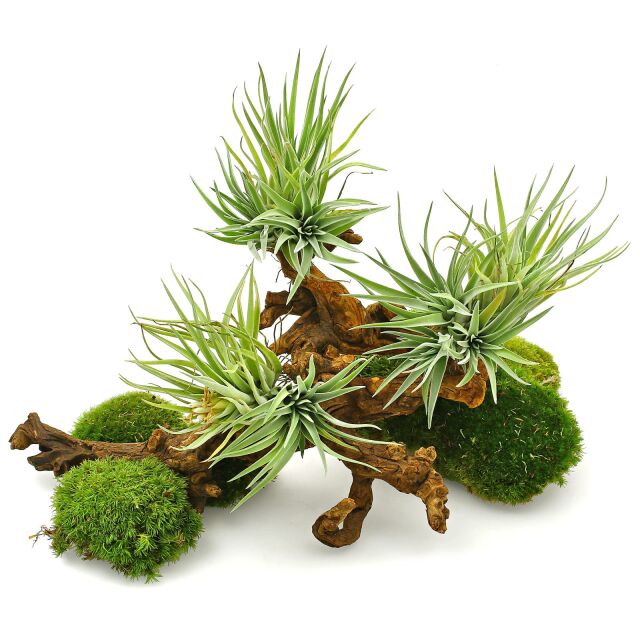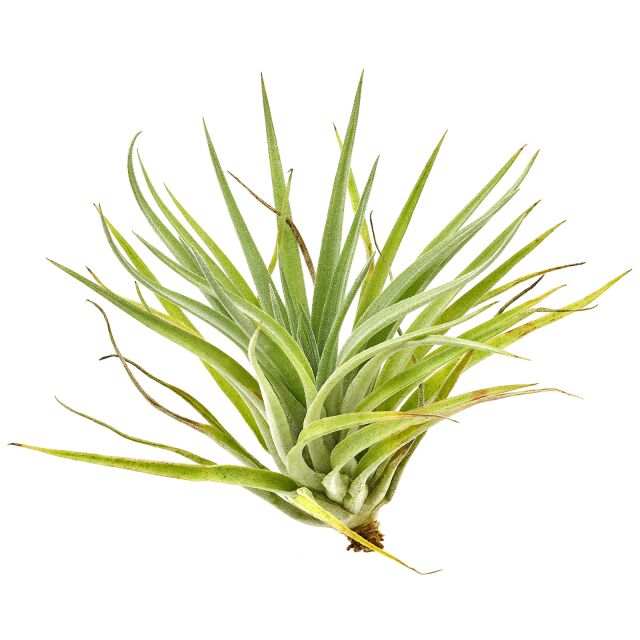Plagiotropic air plant





Tillandsia plagiotropica
Plagiotropic air plant
- Epiphyte from cloud forests in Guatemala and El Salvador
- Regularly formed leaf rosette
- Suitable for rainforest terrariums
Sign in or Register
Item question
We’re here for you!
Please enter your question and e-mail and we’ll contact you as soon as possible. It usually takes us up to 24 hours during business days to respond.
Thank you for your question!
Thank you, we’ll get in touch!
Close window
You already sent us a question.
Please wait a few minutes
Description
Tillandsia plagiotropica is a magnificent, rather small epiphyte from cloud forests in El Salvador and Guatemala at about 1300 - 1700 m altitude. One of the sites is the cloud forest edge on the shore of the crater lake Laguna de los Ninfas north of Apaneca. The thick, grey-green leaves sit in a regular, spreading rosette about 8 - 10 cm high. In nature, the leaf rosettes often grow turned to the side, which is what the species name plagiotropica refers to. During the flowering period, a very short inflorescence forms with yellowish bracts and several long, tubular, white flowers.
Tillandsia plagiotropica belongs to the green or rainforest tillandsias in terms of care requirements, preferring a more humid environment than the so-called grey tillandsias. Nevertheless, it is an "air plant" that can absorb water and nutrients completely via absorbent scales on the leaves. The roots serve mainly as adhesive roots. The plant is attached to a solid base such as wood or stone. It prefers regular moistening and thrives best in a bright area, in daylight cultivation without direct sunlight. Watering can be done by dipping as well as by misting. Optimally, an orchid and tillandsia fertiliser is added every second watering during spring and summer.
After flowering, the mother plant begins to form small daughter rosettes. These can be carefully separated from a size of about one third of the mother rosette. If they are not separated, they grow together to form a larger tuft.
Tillandsia plagiotropica with its strong, regularly shaped leaf rosettes is a pretty epiphyte for smaller and medium-sized rainforest or mountain cloud forest terrariums.
Profile
| Tillandsia plagiotropica | |
| Cultivation options | Epiphytic |
| Growth height | approx. 8 - 10 cm |
| Temperature | approx. 15 - 28 °C |
| Humidity | At least 70 % |
| Light requirement | Bright, in daylight cultivation no direct sun light at noon |
| Watering | Spray every 2 - 3 days with soft, low-lime water, e.g. rainwater, or dip once a week |
| Fertilising | In spring and summer, with every second watering, orchid or Tillandsia fertiliser |
| Propagation | Formation of pups after flowering |
| Suitable for | Rainforest terrariums, tropical mountain forest terrariums |
| Cultivation options |
| Epiphytic |
| Growth height |
| approx. 8 - 10 cm |
| Temperature |
| approx. 15 - 28 °C |
| Humidity |
| At least 70 % |
| Light requirement |
| Bright, in daylight cultivation no direct sun light at noon |
| Watering |
| Spray every 2 - 3 days with soft, low-lime water, e.g. rainwater, or dip once a week |
| Fertilising |
| In spring and summer, with every second watering, orchid or Tillandsia fertiliser |
| Propagation |
| Formation of pups after flowering |
| Suitable for |
| Rainforest terrariums, tropical mountain forest terrariums |
Terrarienpflanzen
Our terrarium plants give every terrarium an individual, natural atmosphere and at the same time provide a healthy environment for all terrarium inhabitants. Our wide range of tropical, subtropical and even arid plants are easy to combine and enhance any terrascape. Whether it's strong succulents, subtle tillandsias, eye-catching neoregelias or wonderful orchids - we offer terrarium plants for different terrascapes from rainforest to desert.
General information
| Item no. |
|
| EAN | |
| Weight | 0,01 kg |
| Shipping weight | 0,02 kg |
Customers ask customers
You have questions about this product? Ask other customer or our support team about this product!